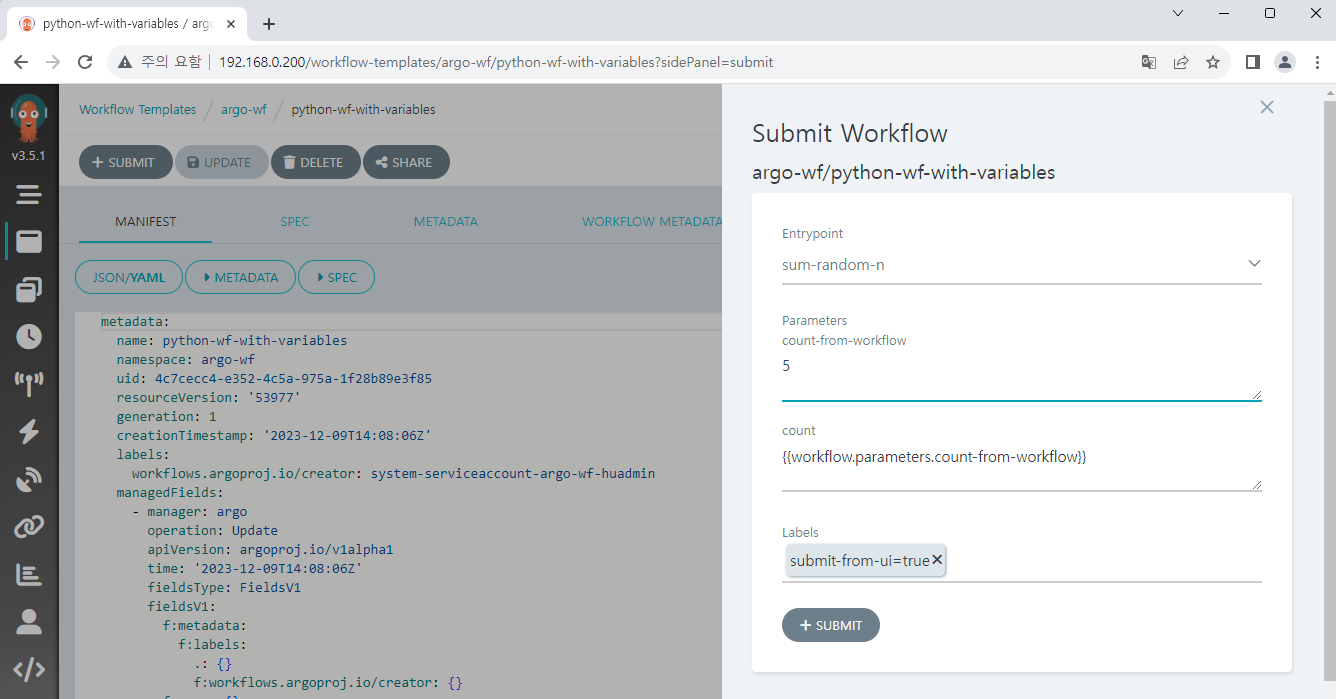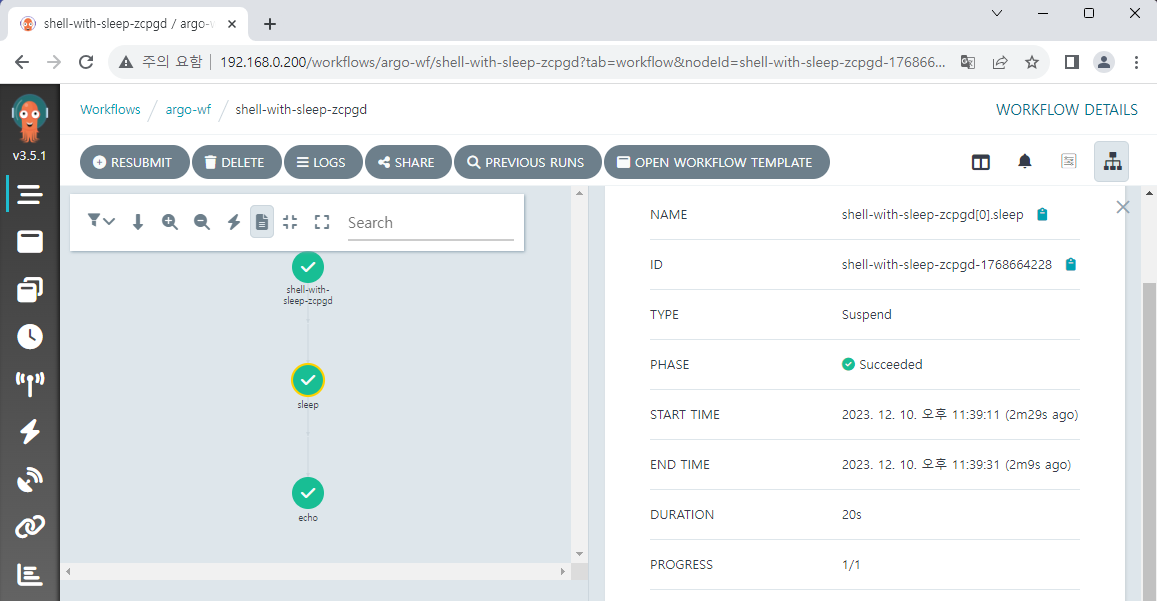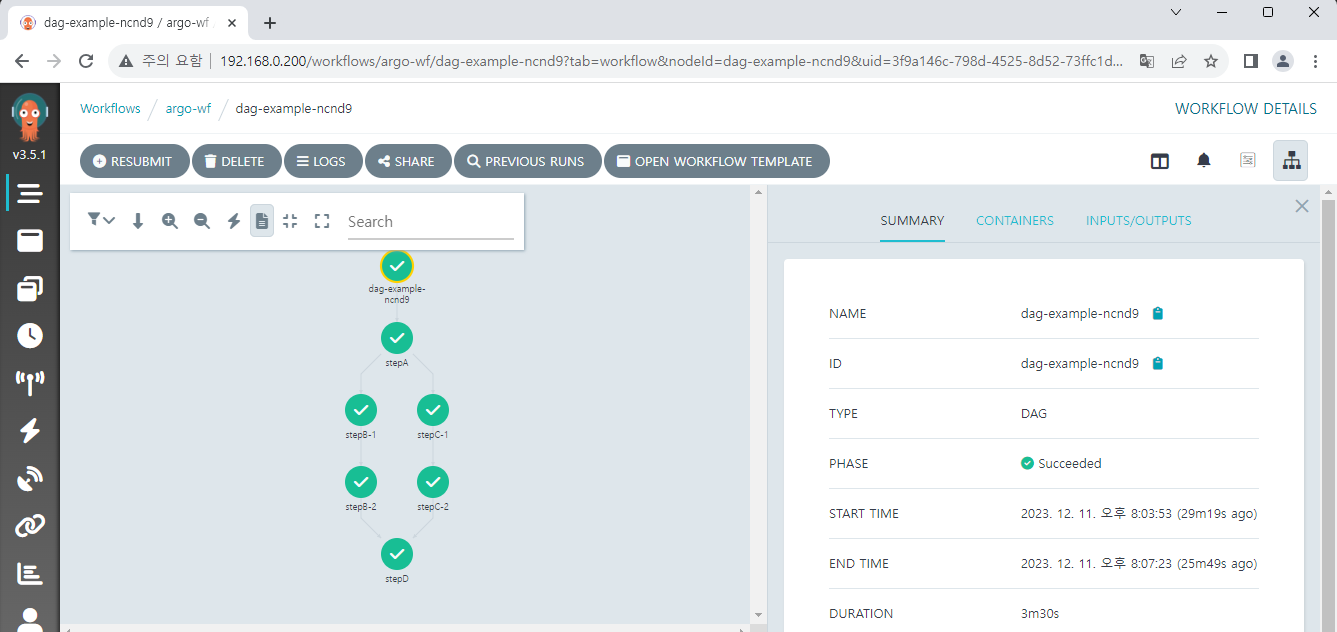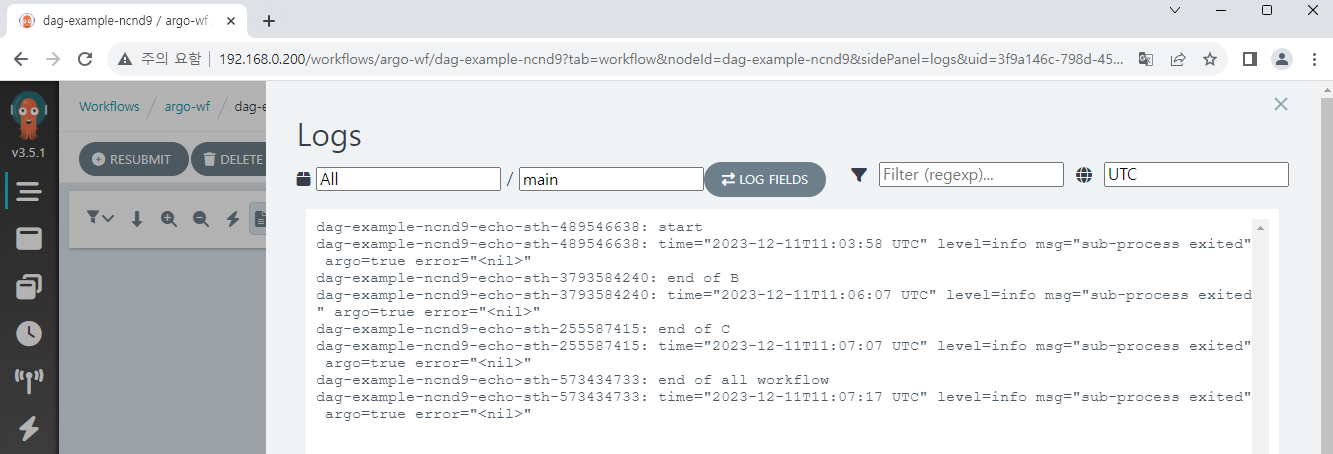Various workflows
Having learned the basic method of creating a workflow, we'll create various types of workflows that are commonly used.
Script
It is possible to directly write and execute scripts with workflow.
Python code is written in here, but shell scripts are also possible.
The code below prints ten random numbers and then adds them up at the end.
apiVersion: argoproj.io/v1alpha1
kind: Workflow
metadata:
name: python-script-workflow
spec:
entrypoint: sum-random-ten
templates:
- name: sum-random-ten
script:
image: python:alpine3.8
command: [python]
source: |
import random
sum = 0
for _ in range(10):
i = random.randint(1, 100)
print(i)
sum += i
print(sum)

Passing variables from workflow
You can pass variables from workflow if you need to control indiviual steps or other various situations from workflow.
This workflow receives the count-from-workflow variable before execution, passes it to the sum-random-n template, and template receives it as the 'count' variable for use in the script.
apiVersion: argoproj.io/v1alpha1
kind: Workflow
metadata:
name: python-wf-with-variables
spec:
entrypoint: sum-random-n
arguments:
parameters:
- name: count-from-workflow
templates:
- name: sum-random-n
inputs:
parameters:
- name: count
value: "{{workflow.parameters.count-from-workflow}}"
script:
image: python:alpine3.8
command: [python]
source: |
import random
sum = 0
n = {{inputs.parameters.count}}
for _ in range(n):
i = random.randint(1, 100)
print(i)
sum += i
print(sum)
The below is a screen where the variable is set to 5.
You can see five random numbers and their sum being printed.


Suspend and Step
Suspend temporarily stops workflow execution and resuming requires a certain amount of time or manual commands to be sent. It has no special function on its own, so it is mainly used with Step or DAG, which will be described later.
The Step feature allows you to literally divide into multiple stages and configure the workflow. It is useful when distinguishing between different roles or combining content from multiple sources in a workflow.
This is the example using Suspend & Step.
We insert value to number-from-workflow variable and pass to the individual templates, suspend-sleep and echo-num.
For example, if you input 20, workflow will wait for 20 seconds and then print 20 using the echo command.
apiVersion: argoproj.io/v1alpha1
kind: Workflow
metadata:
name: shell-with-sleep
spec:
entrypoint: total-wf
arguments:
parameters:
- name: number-from-workflow
templates:
- name: total-wf
steps:
- - name: sleep
template: suspend-sleep
arguments:
parameters:
- name: sleep-time
value: "{{workflow.parameters.number-from-workflow}}"
- - name: echo
template: echo-num
arguments:
parameters:
- name: number
value: "{{workflow.parameters.number-from-workflow}}"
- name: suspend-sleep
inputs:
parameters:
- name: sleep-time
suspend:
duration: "{{inputs.parameters.sleep-time}}s"
- name: echo-num
inputs:
parameters:
- name: number
script:
image: bash:latest
command: [bash]
source: |
echo {{inputs.parameters.number}}
Below is the actual result of inputting 20.


DAG
DAG(Directed Acyclic Graph) is often used to compose pipeline. You can specify the conditions required for executing a specific step by setting dependency, divide Workflow into multiple branches, or integrate results from multiple branches by setting multiple dependencies. You can use DAG in various ways.
This example is a simple implementation of a DAG.
apiVersion: argoproj.io/v1alpha1
kind: Workflow
metadata:
name: dag-example
spec:
entrypoint: total-wf
templates:
- name: total-wf
dag:
tasks:
- name: stepA
template: echo-sth
arguments:
parameters:
- name: word
value: "start"
- name: stepB-1
dependencies: [stepA]
template: suspend-sleep
arguments:
parameters:
- name: sleep-time
value: "120"
- name: stepB-2
dependencies: [stepB-1]
template: echo-sth
arguments:
parameters:
- name: word
value: "end of B"
- name: stepC-1
dependencies: [stepA]
template: suspend-sleep
arguments:
parameters:
- name: sleep-time
value: "180"
- name: stepC-2
dependencies: [stepC-1]
template: echo-sth
arguments:
parameters:
- name: word
value: "end of C"
- name: stepD
dependencies: [stepC-2, stepB-2]
template: echo-sth
arguments:
parameters:
- name: word
value: "end of all workflow"
- name: suspend-sleep
inputs:
parameters:
- name: sleep-time
suspend:
duration: "{{inputs.parameters.sleep-time}}s"
- name: echo-sth
inputs:
parameters:
- name: word
script:
image: bash:latest
command: [bash]
source: |
echo {{inputs.parameters.word}}
Simple explanation: it prints start on step A, then branch into two paths for step B and C. When both sides are completed, it prints end of all workflow on step D and end the process.
When we execute the workflow, even though Suspend is set to 2/3 minutes on each side, since each step progresses simultaneously it takes about 3-4 minutes including bash setup time, instead of more than 2 + 3 = 5 minutes.

